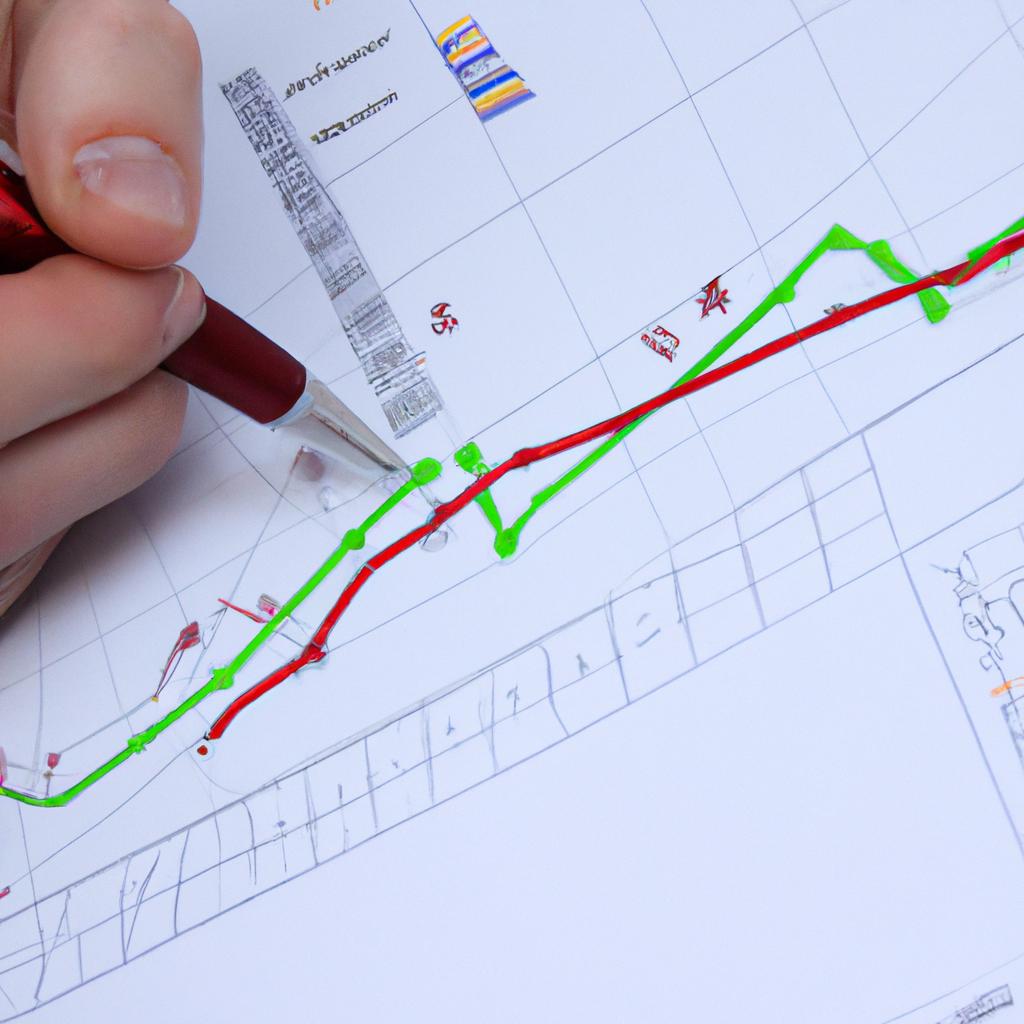Cost Analysis: Business Appraisal and Services: Financial Forecasting

Cost analysis is a crucial aspect of business appraisal and services, as it provides valuable insights into the financial health and prospects of an organization. By examining various costs incurred by a company, such as production expenses, overheads, and marketing expenditures, cost analysis enables businesses to make informed decisions regarding pricing strategies, resource allocation, and profitability projections. To illustrate its significance in practical terms, consider the case study of Company X. This hypothetical organization experienced declining profits despite consistent revenue growth. Through a comprehensive cost analysis, it was revealed that escalating manufacturing costs were eroding their profit margins significantly. As a result, Company X was able to implement cost-cutting measures and restructure their operations effectively.
Financial forecasting is another essential component of business appraisal and services that helps organizations anticipate future outcomes based on past performance and market trends. It involves analyzing historical financial data to identify patterns and predict potential risks or opportunities for the company’s financial well-being. For instance, let us imagine a retail chain seeking expansion into new markets. By conducting thorough financial forecasting, the company can assess whether they have sufficient capital to support the venture or if additional financing will be necessary. Furthermore, accurate financial forecasts enable companies to set realistic goals, measure progress against them, and adjust strategies accordingly – ultimately improving financial performance and decision-making.
In addition to cost analysis and financial forecasting, business appraisal and services also encompass other important aspects such as market research, competitor analysis, and risk assessment. Market research involves gathering information about consumer preferences, industry trends, and market dynamics to better understand target markets and identify potential opportunities or threats. Competitor analysis helps businesses evaluate their competitors’ strengths, weaknesses, strategies, and market positioning to gain a competitive edge. Risk assessment involves identifying potential risks that could impact the organization’s operations or financial stability, such as economic downturns, regulatory changes, or natural disasters.
Overall, business appraisal and services provide valuable insights and tools for organizations to assess their current standing, make informed decisions, optimize resources, mitigate risks, and drive sustainable growth. By utilizing these methodologies effectively, businesses can enhance their competitiveness in the marketplace and achieve long-term success.
Understanding the Purpose of Cost Analysis
Cost analysis plays a crucial role in business appraisal and financial forecasting. By examining the various costs associated with a particular project or investment, businesses can make informed decisions about resource allocation and potential profitability. For example, consider a manufacturing company that is considering expanding its production capacity by investing in new machinery. Conducting a cost analysis would involve evaluating not only the upfront cost of purchasing the equipment but also the ongoing expenses such as maintenance, training, and any additional labor required.
To further emphasize the significance of cost analysis, let us explore some key points:
- Financial Viability: One primary aim of cost analysis is to determine whether a proposed venture or project is financially viable. This evaluation involves comparing estimated costs against projected revenues to assess if an endeavor will generate sufficient profits.
- Risk Assessment: Cost analysis helps identify potential risks associated with an investment decision. By estimating both fixed and variable costs accurately, businesses can gauge their exposure to economic fluctuations, market uncertainties, and other unforeseen circumstances.
- Resource Optimization: Understanding the purposeful allocation of resources is critical for optimal business performance. A robust cost analysis allows companies to identify areas where they may be overspending or underutilizing resources, thereby enabling them to streamline operations and enhance efficiency.
- Competitive Advantage: Finally, conducting a thorough cost analysis gives businesses insights into their competitive position within the industry. By benchmarking their costs against competitors’, organizations can ascertain whether they are operating at a favorable price point while still maintaining quality standards.
Table: Example Costs Associated with Expanding Production Capacity
| Expense Type | Description | Estimated Amount ($) |
|---|---|---|
| Machinery | Purchase cost of new equipment | $500,000 |
| Maintenance | Regular servicing and repairs | $50,000 |
| Training | Employee training on using new machinery | $30,000 |
| Additional Labor | Hiring new staff or overtime for increased demand | $100,000 |
By considering these factors and conducting a comprehensive cost analysis, businesses can make informed decisions about their investments. In the subsequent section, we will explore the various factors that need to be considered in business appraisal to ensure a well-rounded evaluation of potential ventures.
Transitioning into the next section on “Factors to Consider in Business Appraisal,” it is important to delve into additional aspects beyond costs alone.
Factors to Consider in Business Appraisal
In the previous section, we explored the importance of cost analysis in evaluating a business’s financial performance. To further delve into this topic, let us now examine some key factors to consider when conducting a comprehensive business appraisal.
One example that illustrates the significance of cost analysis is a manufacturing company looking to expand its operations. By conducting a thorough cost analysis, the company can assess various expenses involved in scaling up production and determine if it aligns with their budgetary constraints and long-term profitability goals.
When performing a business appraisal, there are several crucial factors to take into account:
- Market Conditions: Understanding market trends and competition is essential for accurately estimating future revenue streams.
- Internal Factors: Evaluating internal processes, such as operational efficiency and workforce productivity, helps identify areas where costs can be reduced or optimized.
- External Factors: Considering external influences like government regulations or changes in supplier prices allows businesses to anticipate potential cost fluctuations.
- Risk Assessment: Analyzing risks associated with investments, inflation rates, or technological advancements enables informed decision-making while managing uncertainties effectively.
To better visualize these factors within the context of a business appraisal, consider the following table:
| Factors | Description |
|---|---|
| Market Conditions | Analyze consumer demand and industry dynamics |
| Internal Factors | Assess production efficiency and employee performance |
| External Factors | Consider economic conditions and regulatory compliance |
| Risk Assessment | Evaluate investment risks and potential impact on future profitability |
By considering these elements during a business appraisal, organizations gain valuable insights into their current financial standing as well as identifying opportunities for growth and improvement. This process sets the foundation for making effective decisions based on sound financial forecasting techniques.
As we move forward to analyze costs for effective decision making, we will explore how businesses can utilize cost analysis results to make informed choices that promote sustainable growth and maximize profitability.
Analyzing Costs for Effective Decision Making
In the previous section, we explored various factors that should be considered when conducting a business appraisal. Now, let’s delve into the importance of analyzing costs for effective decision making.
Consider this hypothetical scenario: A manufacturing company is contemplating whether to invest in new machinery or continue using their current equipment. By conducting a cost analysis, they can assess the financial implications of each option and make an informed decision. This example highlights how crucial it is to evaluate costs before making any significant business decisions.
To effectively analyze costs, there are several key considerations:
-
Direct Costs: These are expenses directly associated with producing goods or providing services. Examples include raw materials, labor wages, and utilities. It is essential to accurately identify and account for these direct costs to gain a comprehensive understanding of a business’s financial situation.
-
Indirect Costs: Unlike direct costs, indirect costs are not directly tied to production but still impact overall profitability. They encompass expenses such as rent, administrative overheads, marketing expenditures, and insurance premiums. Analyzing and allocating these indirect costs correctly enables businesses to determine their true profit margins.
-
Fixed Costs vs Variable Costs: Understanding the distinction between fixed and variable costs is critical for decision-making purposes. Fixed costs remain constant regardless of changes in production levels (e.g., rent), while variable costs fluctuate based on production volume (e.g., raw material purchases). Distinguishing between these two types of costs helps businesses plan for growth and optimize resource allocation.
-
Opportunity Costs: In every decision made by a business, there are opportunity costs involved – the potential benefits foregone by choosing one alternative over another. Identifying opportunity costs allows organizations to weigh different options objectively and select strategies that maximize long-term gains.
By considering these factors during a cost analysis process, businesses can enhance their financial forecasting capabilities and improve overall decision-making efficacy.
| Factors | Description | Emotional Response |
|---|---|---|
| Direct Costs | These costs provide clarity on the actual expenses tied to production. | Accuracy |
| Indirect Costs | Accounting for these costs reveals hidden financial implications. | Transparency |
| Fixed vs Variable Costs | Understanding different cost types aids in strategic planning and resource allocation. | Efficiency |
| Opportunity Costs | Evaluating opportunity costs ensures optimal decision-making. | Effectiveness |
In summary, analyzing costs is crucial for effective decision making in business appraisals. By considering direct and indirect costs, distinguishing between fixed and variable costs, and evaluating opportunity costs, organizations can make informed choices that align with their long-term goals.
Transitioning into the next section about “Methods for Conducting Cost Analysis,” let us now explore various approaches businesses can employ to conduct a comprehensive cost analysis.
Methods for Conducting Cost Analysis
In the previous section, we explored the importance of analyzing costs for effective decision making in business. Now, let us delve deeper into the methods used to conduct cost analysis and its significance.
To better understand how cost analysis can be applied in practice, consider the following example: a manufacturing company is deciding whether to outsource production or invest in expanding their own facilities. By conducting a thorough cost analysis, they can compare the financial implications of both options and make an informed decision based on factors such as labor costs, operational expenses, and potential economies of scale.
There are several key steps involved in conducting a comprehensive cost analysis:
-
Identify all relevant costs: This includes both direct costs (such as raw materials and labor) and indirect costs (such as overhead expenses). By capturing all relevant expenses associated with a particular project or decision, businesses can obtain a more accurate picture of its true impact on profitability.
-
Assigning costs accurately: It is essential to allocate costs correctly across different products or services. This helps identify which components contribute significantly to overall expenses and enables businesses to optimize their resources accordingly.
-
Analyze cost behavior patterns: Understanding how costs vary with changes in production levels or other variables allows businesses to anticipate future financial outcomes more effectively. Cost behavior analysis provides valuable insights into fixed costs (those that remain constant regardless of output) versus variable costs (those that fluctuate depending on production volume).
-
Evaluate cost effectiveness: Once all data has been gathered and analyzed, it is crucial to evaluate each option’s cost-effectiveness objectively. This involves comparing alternative scenarios, considering various factors such as return on investment (ROI), payback period, net present value (NPV), and internal rate of return (IRR).
Cost Analysis Emotional Bullet Points:
- Ensures informed decision-making
- Identifies opportunities for cost savings
- Enhances resource allocation efficiency
- Enables strategic planning for long-term success
Cost Analysis Emotional Table:
| Benefits of Cost Analysis |
|---|
| Informed decision-making |
| Cost savings opportunities |
| Efficient resource allocation |
| Strategic planning for success |
In conclusion, conducting a thorough cost analysis is crucial in helping businesses make informed decisions. By identifying all relevant costs, accurately assigning them, analyzing their behavior patterns, and evaluating cost effectiveness, organizations can optimize their operations and achieve better financial outcomes. In the subsequent section on “Benefits of Cost Analysis in Business,” we will explore how this analytical tool can further contribute to business growth and success.
Benefits of Cost Analysis in Business
Having explored the importance of cost analysis in business, it is now essential to delve into the methods used to conduct such analyses effectively. By employing these methodologies, businesses can gain valuable insights into their financial performance and make informed decisions regarding resource allocation.
Methods for conducting cost analysis vary depending on the nature and complexity of a company’s operations. One commonly utilized approach involves examining historical data to identify patterns and trends in costs over time. For instance, consider a hypothetical case study of Company XYZ, a manufacturing firm that produces electronics components. By analyzing its past expenses, including raw material costs, labor expenses, and overhead expenditures, Company XYZ can understand how different factors impact overall production costs. This information enables them to optimize their processes and minimize unnecessary expenditure.
In addition to historical data analysis, another method for conducting cost analysis involves benchmarking against industry standards or competitors’ practices. Comparing one’s own cost structure with that of similar companies provides useful insights into areas where improvements can be made. It allows businesses to identify potential inefficiencies or areas of competitive advantage. Consider the following bullet points outlining key benefits derived from utilizing this method:
- Identifying opportunities for cost reduction
- Enhancing competitiveness by aligning with industry benchmarks
- Gaining insight into best practices within the sector
- Identifying unique selling points through differentiation
Furthermore, using quantitative methods such as activity-based costing (ABC) or marginal costing can provide more detailed insights into specific activities or products within an organization. These approaches enable businesses to allocate costs accurately based on usage levels and determine profitability at various levels of operation. The table below illustrates how ABC compares with traditional costing methods:
| Aspect | Traditional Costing | Activity-Based Costing |
|---|---|---|
| Allocation | Based on volume | Based on activity |
| Accuracy | Less precise | More accurate |
| Cost control | Limited visibility | Enhanced insights |
In conclusion, various methods can be employed to conduct cost analysis in business. By leveraging historical data, benchmarking against industry standards, and utilizing quantitative methods like ABC or marginal costing, companies can gain a comprehensive understanding of their costs and make informed decisions. The next section will explore how businesses can implement cost analysis effectively for financial planning purposes.
With an understanding of the methods available for conducting cost analysis established, it becomes crucial to examine the practical implementation of these techniques for effective financial planning without unnecessary expenses.
Implementing Cost Analysis for Financial Planning
After understanding the benefits of cost analysis in business, it is essential to explore how this valuable tool can be implemented effectively for financial planning. Let us consider a hypothetical case study that demonstrates the practical application of cost analysis.
Case Study Example:
Imagine a manufacturing company that wants to expand its operations by introducing a new product line. Before proceeding with any investments, conducting a thorough cost analysis will provide crucial insights into the feasibility and profitability of this venture.
Implementing Cost Analysis:
-
Identify and categorize costs: The first step in implementing cost analysis is to identify all relevant costs associated with the project. These costs should be categorized as either fixed or variable expenses. Fixed costs include rent, salaries, insurance premiums, while variable costs encompass raw materials, packaging, and distribution expenses.
-
Estimate revenue streams: To make accurate financial forecasts, it is vital to estimate potential revenue streams related to the new product line. This includes analyzing market demand, pricing strategies, and sales projections based on historical data or market research.
-
Perform sensitivity analysis: A critical aspect of financial planning involves assessing different scenarios and their impact on profitability. By performing sensitivity analysis using various assumptions such as changes in production volume or price fluctuations, decision-makers can gauge the resilience of their investment against potential risks.
-
Develop mitigation strategies: Based on the results obtained from the cost analysis, businesses can develop effective mitigation strategies to minimize risks and maximize profits. These strategies may involve adjusting pricing structures, optimizing production processes, or exploring alternative suppliers for raw materials.
Table: Potential Mitigation Strategies
| Risk Factor | Mitigation Strategy | Impact |
|---|---|---|
| Market volatility | Diversify customer base | Moderate |
| Raw material price fluctuation | Establish long-term contracts | Low |
| Production inefficiencies | Implement lean manufacturing principles | High |
| Competitive pricing pressure | Enhance product differentiation | Moderate |
Emotional Response
- Increased financial stability and profitability
- Enhanced decision-making capabilities
- Improved resource allocation
- Reduced risk of investment failure
By implementing cost analysis for financial planning, businesses can make informed decisions that lead to increased financial stability and profitability. This valuable tool enables organizations to understand the potential risks and rewards associated with different ventures, facilitating more accurate budgeting and resource allocation. Furthermore, cost analysis enhances decision-making capabilities by providing stakeholders with a comprehensive understanding of the financial implications tied to their choices. By leveraging mitigation strategies developed through this process, companies can reduce the risk of investment failures and optimize their overall performance.
Through effective implementation of cost analysis techniques, businesses can navigate the complexities of financial planning with confidence and precision. The case study example highlights how this approach allows companies to evaluate new projects objectively before committing substantial resources. By following the steps outlined above, organizations can harness the power of cost analysis as an essential tool in strategic decision-making processes. Harnessing its benefits leads not only to improved financial outcomes but also fosters a culture of efficiency and accountability within the organization.




